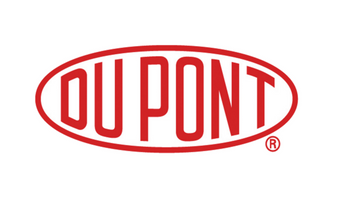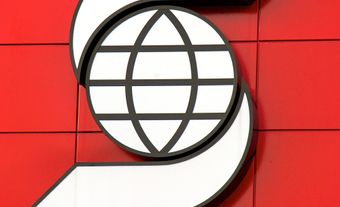Petro-Canada
Petro-Canada, created by the federal government in the mid-1970s as Canada's national oil company, was the offspring of the world energy crisis, Canadian ECONOMIC NATIONALISM, and a tradition of state-supported development of the country's costly energy frontier. Petro-Canada is involved in "upstream" (exploration and development) and "downstream" (refining and marketing) activities. It has major interests in western Canadian production, the Alberta oil sands, the Hibernia and Terra Nova projects of offshore Newfoundland and various international locations, and controls nearly one-fifth of Canada's oil refining and gasoline market (seePETROCHEMICAL INDUSTRY). Employing more than 6000 people around the world, Petro-Canada is one of Canada's largest oil and gas companies.
History
Petro-Canada was created in the mid-1970s, a period when energy issues became the focus of a broad debate in Canada between Prime Minister Pierre TRUDEAU's Liberal minority government and its critics. Trudeau was assailed by nationalists and by the NEW DEMOCRATIC PARTY, which after the 1972 federal election held the balance of power in the HOUSE OF COMMONS. The PETROLEUM INDUSTRY was overwhelmingly under foreign - mostly American - control, the Canadian Arctic was coming under corporate pressure because of the recent discovery of oil in Alaska, and Canada's ENERGY POLICIES appeared to be increasingly oriented to North American rather than domestic needs.
Many national governments had already established state oil companies in the attempt to gain more control over, and knowledge about, the international oil industry. Such companies were used to ensure the security of supplies, to enhance the collection of revenues and to give governments better information about world energy markets, yet they were costly to set up and, over time, tended to become almost indistinguishable from their private-sector counterparts. The Trudeau cabinet initially rejected the idea of establishing a Canadian state oil company on grounds of cost and efficiency.
However, in the fall of 1973 the global structure of oil supply collapsed, oil prices quadrupled, and the major oil companies saw their holdings nationalized in the Arab oil-exporting countries of the Middle East. The resulting uncertainty about having continued oil imports forced Ottawa to reassess its assumptions. Canada, though a temporary net exporter, was vulnerable to a cut-off of imported supplies for Québec and the Atlantic provinces, and it urgently needed to know more about its potential to produce energy from its frontier areas (seePETROLEUM SUPPLY AND DEMAND). The minority Liberals were threatened with parliamentary defeat by the NDP unless they acted to protect consumers and to set up a Crown-owned petroleum company. More radical voices were calling for the NATIONALIZATION of the entire oil industry, and the oil-consuming provinces were strong supporters of federal intervention to enhance the security of supply. Trudeau's government therefore accepted an NDP motion late in October 1973 calling, among other things, for the creation of a national oil company.
The Petro-Canada Act was passed in 1975 after an acrimonious debate in Parliament and created a new CROWN CORPORATION. This corporation was equipped with broad powers to carry out exploration and development and a comprehensive mandate to acquire imported oil supplies; engage in energy research and development; and go into "downstream" activities such as refining and marketing. The new corporation was established with an initial $1.5 billion in capital and preferential access to debt capital as "an agent of Her Majesty," thus reducing its cost of capital; but the Liberal government also drafted the legislation so as to give Ottawa authority over Petro-Canada's capital budget and its corporate strategy. The government wanted to keep its new Crown entity as its policy arm and to prevent it from striking out on its own: it wanted Petro-Canada mainly to be active on the frontiers - the oil sands, the Arctic, the East Coast offshore areas - and not in the conventional oil and gas sector in Western Canada.
Since setting up headquarters in the hostile culture of Calgary in 1976, with Maurice STRONG, the prime minister's friend, as the company's first chair, Petro-Canada's principal object has been corporate growth. It has been oriented to growth rather than profitability because this has served several management interests. Growth was necessary if Petro-Canada was to carry out its job of exploring and developing the frontier oil and gas basins, and also have the autonomy from Ottawa to make its own decisions. Moreover, from its first day of operations, Petro-Canada was the target of a campaign by right-wing oilmen and the federal Conservative Party - then led by Joe CLARK - to disband the company. Clark was a native Albertan who understood the West but grossly underestimated the strength of nationalist sentiment and Petro-Canada's symbolic importance in the rest of the country.
Clark's threat to "dismantle" rather than merely privatize Petro-Canada spurred the company's managers to expand their domain by making a series of corporate acquisitions, the overall effect of which was to make the Crown oil company one of the largest players in the industry, far too large for any government to break up. Petro-Canada survived the brief minority Conservative government headed by Clark in 1979-80, the years of the "second oil crisis," because it was able to link its own fate to Canadians' fears about the supply, price and ownership of energy. It held a share in the big Hibernia oil find off Newfoundland and was a partner in the Syncrude oil sands venture in Fort McMurray, Alberta, both of which were identified in the public's mind with security and national control.
The Liberals returned to power in 1980 and soon introduced their controversial NATIONAL ENERGY PROGRAM (NEP), which included plans for a greatly expanded Petro-Canada, "as large as any multinational," the federal Energy Minister stated. Its roles under the NEP were multiple and costly. It was to advise the government, import oil, accelerate oil sands exploitation, act as a catalyst in frontier exploration and development, collect economic rents and other benefits, and help "Canadianize" the entire oil industry. It also had substantial "downstream" assets to operate. All of these mandates entailed large expenditures for delayed returns, expenditures that could only be justified under the assumption - which was conventional wisdom in most governments - that oil would be insecure and very costly throughout the 1980s and 1990s.
This assumption proved to be incorrect and by 1981-82 the world oil industry was in its worst crisis of overproduction, falling prices and glutted markets in 50 years. The oil-exporting countries lost their control of prices, which plummeted from over $40 per barrel to less than $10 per barrel in the space of a few months. In these circumstances of overcapacity, the case for having state oil companies that could take the longer view and focus on security of supply was much less persuasive than it had been. Well before Brian MULRONEY's Conservatives took power in 1984, Petro-Canada had begun to look to its own resources and to fashion a strategy to manage its growing empire on conservative, market-driven principles. Ottawa no longer intervened in company policy. Petro-Canada wrote off several of its costlier frontier projects, and, in an especially rigorous move, summarily fired 2000 employees - nearly 25% of its workforce - in response to falling prices.
Petro-Canada's need for new equity capital and management's desire to be freed of the obligation to serve as a policy arm of the state pointed to a predictable outcome: the corporation, with its estimated $6 billion in taxpayer-owned assets, must be privatized. Partial privatization began in 1991 when Petro-Canada listed on stock exchanges across the country, selling about 30% of its shares, and continued in 1995 when its shares were listed on the New York Stock Exchange. By that time, private investors held about 81% of the shares in Petro-Canada and the government of Canada held the remaining 19%. Since no single investor could hold more than 10% of the public offering, foreign ownership was restricted to 25% of the public float (50% starting in 1996 while the voting limit remained at 25%), and the federal government refused any intervention in Petro-Canada's affairs, control of the company remained firmly in the hands of the operating management.
In the years that followed, Petro-Canada streamlined its operations by selling off ownership interest in buildings and other assets judged non-essential to its continued operation while, at the same time, strengthening its operations in core areas such as with the acquisition of Amerada Hess Canada Ltd in 1996 for $735 million, by which it gained significant proven oil and gas reserves in the process.
In 2000, the 25th year of Petro-Canada's existence, the company achieved its highest earnings to that date, posting a net income of $893 million (9.5% of revenues), almost a four-fold increase over the previous year's earnings of $233 million (3.8%).
Petro-Canada completed its largest purchase to date in May of 2002, the acquisition of the majority of Veba Oil's international oil and gas operations for $3.2 billion, nearly doubling its output of barrels of oil per day.
The Canadian government's desire to further decrease its, and thus the taxpayers', participation in the marketplace led to the sale of its remaining share of 19% of Petro-Canada in September 2004 for almost $3.2 billion, bringing to a successful conclusion the privatization that was started in 1991.
In March 2009, Petro-Canada and Suncor, a Canadian oil development and exploration company employing about 6500 people, announced their plans to merge operations in a transaction that would see combined revenues rise to $54.6 billion (US $43.4 billion).
Operations
Petro-Canada is an integrated oil and gas company engaged in both upstream and downstream activities. On the upstream side of the business, it maintains extensive Canadian as well as international exploration and production interests, which include, among others, the Terra Nova and Hibernia production facilities off Canada's East Coast, various oilsands projects in Alberta's North, and various locations in the North Sea.
For the 2003 fiscal year, the company reported record operating revenues of $27.6 billion and a net income of $3.1 billion (11% of revenues). Its downstream business (refining, marketing, and distribution) contributed almost 59% of net revenues with the remainder coming from its upstream operations, which are grouped as follows: North American Natural Gas, East Coast Canada, Oil Sands, and International.
By the end of 2008 Petro-Canada was producing more than 418 000 barrels of oil equivalent per day comprising crude oil and equivalents and natural gas, with just over one-third coming from its international operations. Its natural gas production worldwide in 2008 came to 706 million cubic feet per day, 83% of it coming from Canadian sources.
On the downstream side, which accounts for two-thirds of the company's business, Petro-Canada operates two refineries located in Edmonton and Montréal, and a lubricants plant in Mississauga, Ont. Across the country, the company has a vast network of retail outlets, numbering 1323 in 2008, 60% of them in Ontario and Québec combined, whereas the majority of its 233 truck stop locations are located in Canada's three westernmost provinces.
Community Work
The former crown corporation is an active supporter of the community and is well-known for its support of the Olympic Torch run leading up to the 1988 Calgary Olympics. The proceeds of the merchandise sold during this time were used to establish the Olympic Torch Scholarship Fund, which since 1988 has paid more than $6 million to more than 2000 Canadian athletes and coaches. The company is also a major donor to amateur athlete development efforts in connection with the 2010 Olympic Games.
Recognizing the impact of its operations on Aboriginal communities, the company created an Aboriginal Relations Team in 2001 to better understand the needs and sensitivities of Canada's First Nations. One of the key outcomes of this process was the creation of the position of Manager of Aboriginal Affairs, who oversees the company's efforts in this regard, including the appointment of advisors from the Aboriginal community to help the company implement its plans.
Petro-Canada's exploration and production activities, by their nature, have an impact on the environment, something the company has long recognized and acted upon, for example by combining forces with the Pembina Institute for Appropriate Development to create the "Alberta Ecotrust." In Atlantic Canada, Petro-Canada is the major private-sector organization involved in the Conservation Corps of Newfoundland and Labrador, which carries out residential energy assessments and promotes awareness of climate change.

 Share on Facebook
Share on Facebook Share on X
Share on X Share by Email
Share by Email Share on Google Classroom
Share on Google Classroom


